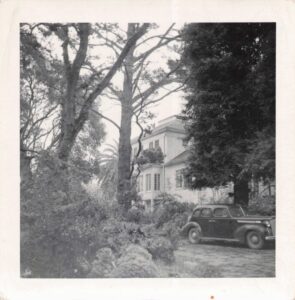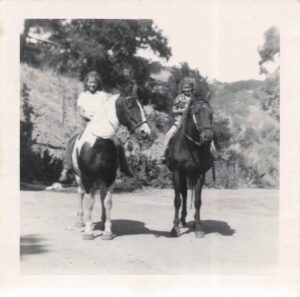Conveniently located just two minutes off the 280 freeway, Edgewood Natural Preserve is a great place to enjoy nature with family and friends any day of the week. The park covers 467 acres of woodlands and grasslands and features over 550 different types of plants, including 10 that are rare or endangered. Visitors who come to the park in the spring (March–June) will be treated to a fabulous wildflower display and will have the option to join docent led tours courtesy of the Friends of Edgewood.
For interactive park habitat displays, visit the Bill and Jean Lane Education Center, which opened in 2011 after a decade of Foundation fundraising. Also, there is an inviting grassy area and tables perfect for an afternoon or evening picnic. The park has 10 miles of trails and is a popular spot with hikers, runners and equestrians.
Natural Features
Fortunately for wildflower enthusiasts, Edgewood contains large exposed formations of serpentine rock in the grasslands. Serpentine is the state rock of California and is blue-green in color with a waxy sheen. It was formed over 35 million years ago by the convergence of the Farallon and North American tectonic plates. Serpentine soil and rocks create a habitat poor in nutrients yet rich in heavy metals. The plants and flowers at Edgewood are uniquely suited to this harsh soil environment and they flourish in the spring.

Spring wildflower displays are the highlight of Edgewood Park & Natural Preserve.
Other sections of the park include oak woodlands with shaded trails covered in ferns, mosses and herbaceous plants. Early morning hikers might have the opportunity to see deer, rabbits, squirrels, raccoons, and skunks, as well as the more elusive bobcat or coyote. Snakes and lizards can also be found in the park. In addition, Edgewood Natural Preserve is one of the few remaining places where visitors can see the endangered Bay Checkerspot Butterfly. In caterpillar form, it likes to eat the California plantain and owl’s clover, both of which are present in the park.
Several spots in Edgewood Natural Preserve offer panoramic views of the peninsula. On a clear day, it’s possible to see all the way to the East Bay in addition to more familiar sites nearby.
History
Hunters first came to the region 6,000 years ago and in approximately 500 AD the Ohlone people arrived in the bay area. Nearby archaeological sites at Filoli Estates and Phleger Estates have both been identified as Ohlone. Gaspar de Portolá explored the area in 1769, the first recorded Ohlone-Spanish encounter.
In the next century, some residences were erected on the current day park site. The first modern residence was erected by John Isaac, an Englishman who arrived in San Mateo County in 1891. He purchased an exhibition structure from the California Midwinter International Exposition in Golden Gate Park in 1894, and it was moved to the site first by train and then in sections by horse.

The Taylor House at “Baywood Glen”
The two-story family home was sold in 1903 to Henry Finkler, of Prussian ancestry, who became secretary to the elected Clerk of the California State Supreme Court, Benjamin Grant Taylor. He became obsessed with recording the area’s weather statistics, some believing his data to be the basis for Redwood City’s claim to have a “climate best by government test.” Henry Finkler obtained a certification granting the name “Baywood Glen” to the estate along with another that designates a location high up on the hill as “Inspiration Heights.” That was the site he hoped to develop as a way-station, half-way between San Francisco and San Jose, where travelers between the two cities might rest overnight, but it never materialized.
Upon his death in 1930, Mr. Finkler bequeathed his estate in equal parts to his late wife’s relative, Michael Purcell, and to his friend and colleague Benjamin Grant Taylor. Mr. Taylor bought out Purcell’s share. For nearly 4 decades, three generations of the Taylor family lived on the land growing fruits and vegetables and raising goats, chickens, cows, horses, and more until the State took possession through eminent domain in 1967. The State wanted the site for a future state college campus. The campus idea fell through, and San Mateo County purchased the property in 1980 for $2.3 million, announcing plans to use part of the site for a golf course.

Edgewood Park & Natural Preserve is easily accessible off I-280 and offers panoramic views across the peninsula.
Biologists, botanists and local residents who knew the ecological treasures of the site opposed the idea of a golf course. Suzanne Somers, a local resident who had begun documenting the hundreds of species of plants she found at the site in the 1960s (even discovering several that were endangered), used her extensive data to substantiate her 25-year crusade to save the land from development. She helped form the Save Edgewood Park Coalition, composed of more than 50 environmentally interested organizations. One of their early successes was to rid Edgewood of the off-road vehicles and mountain bikes that were tearing up the land. Finally, a 15,000-signature petition was presented to the County Board of Supervisors to protect the park from the golf course development, and in 1992, the supervisors recommended the park become a natural preserve. Officially accomplished in 1993, Edgewood is the only natural preserve in San Mateo County.

Carol and Trish Taylor with their horses Popcorn and Lucky in 1955



